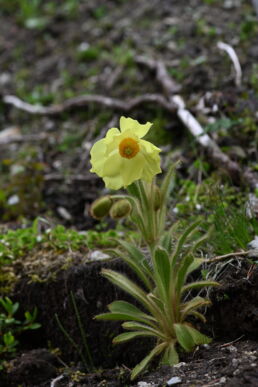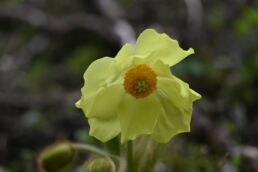Garden-News
June 23 | Plant of the week Part I
Garden-News
The Guggerbachtal-Alpinum open again
The coveted meconopsis (false poppies) begin to flower.
The false poppies are very popular in the garden world, but tricky fellows. They all come from great heights, up to over 6000 m above sea level in the Himalayas. In the garden you need similar requirements as in the distribution area. They grow on mineral mostly acidic, silicate soils, with deep limestone. For this they need enough moisture and high UV radiation, especially during their vegetative growth. The best known false poppies are the blue flowering species. But there are also species that bloom pink, red, violet, white and yellow. Some are dwarfs, only 10 cm tall, others reach up to 180 cm. About 45 species are known, of which there are short-lived and long-lived. The short-lived are mostly monocarpic. This means they flower only once in their life and survive by self seeding. Most monocarpic species flower in the second or third year after sowing. But if the weather doesn’t suit them, they like to push the flowers a little ahead of them and bloom a year or two later.
The picture is showing the monocarpic species Meconopsis integrifolia up in the Guggerbachtal-Alpinum
June 22 | Garden-News Part II
Garden-News
The family of peonies
After the rain, the garden is hardly recognizable. In part, that’s because many new plants have been planted and are now blooming for the first time on Schatzalp. Others are now well established and blooming more profusely than ever before. Among them are the peonies.
Im Alpinum interessiert man sich besonders für die Wildarten der Päonien, wie sie botanisch heissen. Alle kommen in Gebirgsregionen vor, von den Südalpen bis nach Ostasien. Auf der Schatzalp bekannt sind um die 35 Arten, darunter viele krautige (staudige) und auch verholzende Arten. Einige stehen nun in Blüte, andere in Knospen. Die Pfingstrose hat den Namen «Prachtstaude» für die grossblumigen Stauden wohl mitgeprägt.
The picture shows the rare “Paeonia mairei”, a particularly beautiful red flowering form. It was named in honor of a French missionary, Père Edouart-Ernest Marire, who discovered it in 1913. It comes from the mountains of Tibet and central China. Most plants bloom pink and the joy of this red-flowered individual is very great.


